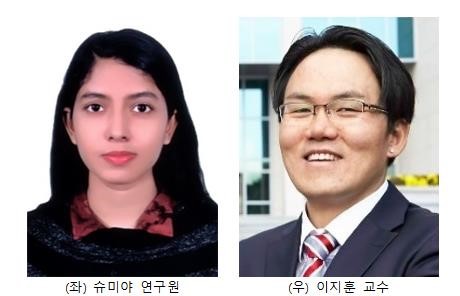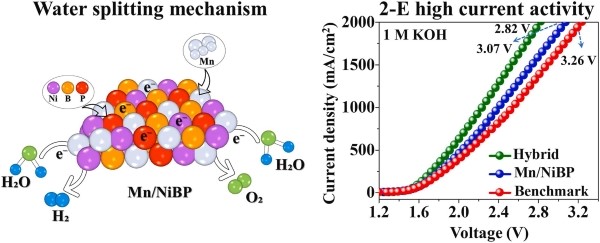Professor Lee Ji-hoon ’s Research Team Develops Hybrid Mn-Doped NiBP Electrocatalyst for Low-Cost
- admin
- 2025-01-21
- 1561
· Professor Lee Ji-hoon (Department of Electronic Engineering)’s Research Team Develops Hybrid Mn-Doped NiBP Electrocatalyst for Low-Cost, High-Efficiency Green Hydrogen Production
Views 87 | Created on
2025.01.02 | Modified on 2025.01.02 | Public Relations Team
·
Professor Lee Ji-hoon (Department
of Electronic Engineering)’s Research Team
Develops
Hybrid Mn-Doped NiBP Electrocatalyst for Low-Cost, High-Efficiency Green
Hydrogen Production
- Development of a
Novel Mn-Doped NiBP Microsphere Electrocatalyst Using Combined Hydrothermal and
Electrochemical Deposition Methods -
- Published in the
Prestigious Academic Journal “International Journal of Hydrogen Energy” (IF:
8.1) by Elsevier -
Professor Lee Ji-hoon
(Department of Electronic Engineering) and his research team, in collaboration
with first author Sumiya (Researcher, Department of Electronic Engineering),
have successfully developed the world’s first hybrid “Mn-doped NiBP microsphere”
electrocatalyst. This innovative structure, designed for low-cost,
high-efficiency green hydrogen production, was achieved by combining
hydrothermal and electrochemical deposition techniques.

+)
two-electrode system demonstrated a low cell voltage of 3.07 V at 2000 mA/cm² in 1M KOH,
outperforming the benchmark reference Pt/C (-) || RuO₂ (+)
electrodes. Additionally, the Pt/C (-) || Mn/NiBP (+)
hybrid system exhibited an ultra-low cell voltage of 2.82 V at 2000 mA/cm² in
1M KOH, demonstrating the electrocatalytic robustness and strong corrosion
resistance of the Mn/NiBP microspheres. Doping Mn into NiBP microspheres has
been shown to accelerate charge transfer and enhance electrocatalytic activity,
making it a cost-effective electrocatalyst candidate for industrial applications.

Schematic
illustration of the novel “Mn-doped NiBP microsphere” electrocatalyst developed
using a hybrid Mn doping method by combining hydrothermal deposition and
electrochemical deposition techniques (International Journal of Hydrogen
Energy, 2024)
The research team
consists of Sumiya Akter Dristy (Ph.D. candidate, Kwangwoon University, first
author), Shusen Lin (Researcher, Key Research Institute, Kwangwoon University),
Md Ahasan Habib (Ph.D. candidate, Kwangwoon University), Mehedi Hasan Joni
(Ph.D. candidate, Kwangwoon University), Rutuja Mandavkar (Ph.D. candidate,
Kwangwoon University), and Lee Ji-hoon (Professor, Kwangwoon University,
corresponding author). The study was conducted solely by Kwangwoon University.
Researcher Sumiya Akter Dristy joined the integrated master's and Ph.D. program
in the Department of Electronic Engineering at Kwangwoon University in 2023 and
is currently in her second year of the program. Researcher Sumiya has actively
participated in studies on quantum and nanostructures as well as materials
science, publishing multiple research papers to date. Researcher Sumiya
expressed her ambition to continue producing outstanding research outcomes and
to further her studies at leading research institutions in the future.
This research was conducted with the support
of the Brain Korea 21 Plus (BK-21) program, the Key Research Institute
program―both funded by the National Research Foundation of Korea and the
Ministry of Education―and Kwangwoon University. The findings were published in
the December 2024 issue of the scientific journal International Journal of
Hydrogen Energy (JCR IF: 8.1) under the title "Manganese doped NiBP: A
promising electrocatalyst for sustainable hydrogen production at
high-current-density (HCD)." * Publication Web link:
https://doi.org/10.1016/j.ijhydene.2024.11.283
Meanwhile, Professor
Lee Ji-hoon’s research team is currently working on the development of
high-efficiency, high-performance energy materials, various metasurface-based
nanomaterials, and optoelectronic device and system technologies. To date, the
team has published over 180 papers in top-ranked SCI JCR journals. Professor
Lee Ji-hoon serves as an Assistant Editor and Editorial Board member for SCI
journals published by globally renowned publishers, as well as a Guest Editor
for various SCI-grade international journals. He also holds various committee
and organizer roles in international conferences. For over 20 years, he has also served as a
reviewer for more than 30 SCI journals, including Advanced Materials (IF 27.4),
Nano Energy (IF 16.8), and Advanced Functional Materials (IF 18.5).